by Rafaël Newman
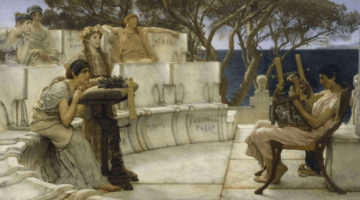
Because I work part time developing a terminology database at a large econometric institute; and because it is important that, in this capacity, I remain abreast not only of raw vocabulary but also of the substance of recent developments in financial technology, known by its Orwellian moniker “FinTech”; and because the owl of Minerva flies at dusk—for all these reasons I recently dusted off my book-bag, packed my reading glasses and a roll of antacid, and registered for a course on blockchain, crypto, and digital currencies.
The three-month program I attended, leading to a so-called Certificate of Advanced Studies (CAS), was offered at the University of Zurich’s Blockchain Center, an interdisciplinary institute ranked fourth for university teaching of distributed ledger technology worldwide. And indeed, my fellow students had come from as far afield as Australia, India, and Brazil, as well as from various corners of Switzerland and Europe, presumably in the hopes of profiting from cutting-edge technical expertise in their work back home as computer programmers, bankers, and jurists.
Instruction was provided by a changing roster of professors in three modules of several full days each, devoted respectively to the IT, economic, and legal dimensions of the new(ish) technology. Each module was punctuated by an assignment, to permit evaluation of the participants: the IT module closed with an online multiple-choice test; the economic component was rounded out with a series of group-work exercises; and the legal section, and thus the course as a whole, concluded with a written essay, on a topic chosen from among suggestions made by the various professors, one of whom, depending on the student’s choice of topic, would then serve as supervisor.
I passed the multiple-choice test, largely thanks to the open-book provision—even if consulting several hundred PowerPoint slides in order to answer 40 questions in one hour’s time proved a greater challenge than advantage, especially when applications unexpectedly froze or quit. The group-work exercises, next, concerning “business cases” drawn from the used-car, travel, and gaming industries, I navigated successfully with my colleagues; working together was also a congenial way to share what one had learned with other participants, many of whom (unlike me) had real-world experience with finance, as well as other commercial sectors.
Which has left me, since the end of October, with only the final assignment to complete. Alone. Due by the end of this week. On a topic of my choosing, selected from among such options as “State of proof-of-stake in public blockchains”, “A practical comparison of Marlowe and Solidity”, “Disintermediating proprietary platforms using blockchain technology”, and “Chances and challenges of the new DLT trading systems legislation”. After a brief but intensive review of my academic background, which, despite the immersion I had just enjoyed in some gnarly issues of computer science, commerce, and the law, qualified me to write confidently in none of the course’s three main disciplines, I chose the most open-ended, least technical-sounding topic—“Describe a new business model based on Ethereum/Cardano/Solana (or another public blockchain)”—: the one that might best lend itself to a decidedly soft-factors project. As supervisor I selected Helmut Dietl, Professor of Services & Operations Management in the Department of Business Administration at the University of Zurich, the lecturer who had struck me as the most receptive to a cultural approach; his day with us, after all, had included group work on Vinci, a platform designed to better distribute royalties to musical artists, and thus, eventually, to compete with Spotify.
All I needed now was a new business model.
I was at a loss. How was I to make coherent sense of the mass of information I had received over the past two months—the arcana of cryptography, notary nodes, the validation of transactions, and the minting of tokens; the profits and pitfalls of blockchain technology used for all manner of ends, well beyond the crypto-currencies with which we laypeople commonly associate it; the vagaries of securities regulation, the seductive but potentially traitorous deployment of smart contracts, and the Kraken known as a decentralized autonomous organization, or DAO? More importantly, how was I to apply any of it, in any sensible fashion, to a topic of relevance to my own “native” field of endeavor, viz. the production, translation, and editing of literary work?
It was during this period of wandering in the virtual wilderness that I attended the opening of an exhibition at the Zurich gallery where my elder daughter works, and, by a happy coincidence, an idea for my final assignment fell into my lap. The Kunsthalle Zürich, a non-commercial art space with both municipal and cantonal support, shows contemporary visual and performance art from Switzerland and around the world. Recent exhibitions have featured work by Igshaan Adams, of South Africa; Liz Larner and Trajel Harrell, from the US; and the Swiss-based painter and sculptor Lorenza Longhi. The show that opened last month, and which runs into the new year, is “DYOR: Do Your Own Research”, and is devoted to “art in the context of blockchain and NFTs”. Curated by Nina Roehrs, “DYOR” features “crypto art” by Dada Collective, XCOPY, and Larva Labs, as well as a lurid Pepe the Frog Space (and Store) and a useful didactic display and timeline of art created as NFTs, or “non-fungible tokens”, the cryptographic medium that promises to restore a Benjaminian aura to the abyss of the digital space.
As absorbing, amusing, and perplexing as all of this was, however—and despite the opportunity it afforded me to swan about, showing off my newfound, if surface-deep acquaintance with hashing, Byzantine Failure Tolerance, and other techie shibboleths—it was not the immediate source of my inspiration. Rather, it was two chance encounters I had with other visitors to the vernissage that provided me with the spark I had been lacking. One of these was Yehudit Mam, a writer and member of dada.art, who had recently “minted” her Spanish-language novel Quién te manda in the form of an NFT on the Ethereum blockchain; and the other was Pierre Lumineau, a designer and editor who himself creates visual art NFTs and who manages the online poetry journal Bestiaire Intime, to which I am a regular contributor. Yehudit (AKA Judy) Mam told me about theVERSEverse, an online “gallery” of NFT poems; Pierre suggested we think about minting NFT poems of our own—and the kernel of a topic for my CAS project began to sprout in my mind. Particularly when I visited theVERSEverse online and read the proposal, made by one of its founders, the poet, artist, and AI researcher Sasha Stiles, that “poetry is the original blockchain”. For the first time, what I had been learning at the University of Zurich began to come to life: distributed ledger technology as a decentralized mnemonic system, embedded in a culture dependent on data but prone to forgetting. An immutable, consensus-based registration of claims of ownership as the mainstay of a tradition in which proprietary authorship and proof of authenticity are invaluable, and the source of esteem, both artistic and economic. A chain of “copies” designed to preserve belles lettres, mythical history, and wisdom poetry in a manner that recalls the memorized recitations of the oral tradition, but which takes them several technological steps farther. The proposal I am now in the final stages of writing up as my final assignment for my CAS is for a poetry journal comprised of contributions of contemporary lyric verse in the form of mp4s, featuring their authors reading them to the camera, in the style of the short-lived and sorely missed YouTube channel iblamepoetry, and minted as NFTs. These are then to be made available for sale on the Solana (or perhaps Tezos) blockchain, with “royalties” (in the form of SOL, Solana’s “native token,” or tez, the token used by Tezos) and divided among all participants—poets, editors, and subscribers—in the manner of a system for sharing ad revenues known as the Basic Attention Token, or BAT.
With the help of more technically versed colleagues, I have managed to flesh out my ideas in a plausible fashion. The journal I propose is to be called Common Speech, in a formulation cited from “A Perfect Market”, a poem by the late Australian man of letters Clive James, in which he cites the French Renaissance poet Pierre de Ronsard in a plea for contemporary verse that is both elegantly musical, and true to the cadence of natural, spoken language: “Recite your lines aloud, Ronsard advised, / Or, even better, sing them. Common speech / Held all the rhythmic measures that he prized / In poetry.”
The journal is naturally just an idea, its realization hampered by some formidable technical “issues”: the cost of minting such unwieldy (while also admittedly “old-school”) artifacts as mp4s; the problem of where to “store” them, and not simply the code that “points” to them, once minted; and the fact that, in the wake of the recent bankruptcy of the FTX exchange, the fate of the Solana blockchain seems suddenly uncertain, since Sam Bankman-Fried’s flimflam venture was evidently among its major shareholders. But this hasn’t stopped me daydreaming about the new journal, or speculating about what some poetic forebears might have made of the project, or indeed of the technology underpinning it. Because one of the oddest and most gripping features of the blockchain “world”, it turns out, as well as the last thing one might expect of what is in essence a high-tech accounting system, is the whiff of science fiction and video games it exudes—although maybe it’s not all that surprising after all, when one recalls the “cypherpunks” and hard-core IT nerds who watched over its cradle. For instance, the Ethereum blockchain, pioneered by teen wunderkind Vitalik Buterin during the halcyon days in the aftermath of the emergence of Bitcoin (itself created by the still mysterious cypher “Satoshi Nakamoto”), was invented to support so-called DApps (decentralized applications), such as smart contracts or the Decentralized Autonomous Organization (DAO). This latter, essentially a gigantic exchange or mutual fund, was launched in 2016 and was soon subjected to an attack by hackers, who siphoned off enormous quantities of crypto. This in turn obliged the Ethereum Foundation to re-conceive its code and create a “hard fork”, or divergence in the chain—a fundamental taboo among purists, who cleaved to the original chain, maintaining that “code is law” and reasoning that the “DAO hack” was in fact a feature, not a bug, and that the ideology of decentralization, immutability, and trustlessness underpinning the blockchain demands that no rejigging ever take place. What had happened with the “fork” was thus in essence time travel, or the production of two alternative realities: a “world” (= blockchain, conceived as a form of narrative) in which the DAO hack had never taken place, and for which the code had been adapted to circumvent that cataclysmic event; and a “world” in which the hack had indeed happened, and the loss that it had incurred was simply accepted as the price of new knowledge. There have been further forks, updates, and milestones in the Ethereum blockchain since, bearing fanciful, semi-fictional or contrary-to-fact names (Bellatrix, Constantinople), all of this belying the ostensibly prosaic character of the exercise involved.
This sort of Dungeons-and-Dragons, Wrinkle-in-Time stuff has permeated the internet since its earliest days, of course, and is an integral feature of Web3, in which the Metaverse, by way of Mark Zuckerberg’s avatar, may seem to promise a world in which 9/11 “never happened in here!” (Although even that meme has since been proven a hoax—or fork…) Thus conceived, the blockchain offers a vision of reality that responds to the lament of Aslan, the Christ-like lion in C.S. Lewis’s Chronicles of Narnia (one of the Ur-texts of the fantasy genre), who ruefully reminds us that “we are never told what might have been”. Now, with blockchain technology, we are told; and we can construct what might have been to suit our own narratives!
As an alternative to the rather more straight-laced periodical proposed in my final assignment, then, let me here create a literary fork, my very own Dead Poets’ DAO, whose genesis block contains three heretofore non-extant strophes by Sappho. Work by the prolific archaic Greek poet from the island of Lesbos, who may have gone into exile on Sicily in the early 6th century BCE in the wake of political turmoil, survives only in a very few fragments, tattered papyrus found in a rubbish tip at Oxyrhynchus in Egypt and comprising only a very small percentage of her estimated complete corpus. What we know, or think we know, about Sappho is that she pioneered lyric poetry as a medium for the expression of personal sentiment: the individuation of a solo voice out of the ensemble of the antique chorus. She was a contemporary of the Mytilenean poet Alcaeus, with whom she may well have performed in public, who was himself embroiled in bitter local politics, who was eventually exiled, and who has lent his name to the distinctive meter—Alcaics—often also used for compositions by his female colleague.
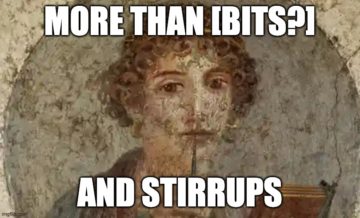
Sappho was evidently given to vivid imagery and simile (“He seems to me equal to the gods that man / whoever he is who opposite you / sits and listens close / to your sweet speaking”, declaims a renowned fragment, in Anne Carson’s translation; and further: “tongue breaks and thin / fire is racing under skin / and in eyes no sight and drumming / fills ears”). So here is my psychedelic version of the revenant Lesbian, “the tenth Muse”, using blockchain as a rhetorical figure for the expression of desire—not just a fragment now, because…well, there’s been a fork in this blockchain, from before all that papyrus got torn up and tossed away in the Egyptian provinces, and was instead preserved at the Great Library in Alexandria, which in turn did not dwindle and perish during the decline of Roman rule and the rise of Christianity:
Silver may be worth more than sweet embraces,
More than horses swift, more than bits and stirrups.
Weigh, though, against them honor, given freely:
That may prove dearer.Gods! If you’d only fashion a chain to bind
A faithless mistress, her pledge ethereal,
But set down openly in crafty contracts:
None could deny it!Ah, but those gods would still our masters be,
Lurking in their webs like malicious spiders.
Only the Fates can sever such a binding;
Only they know the code.
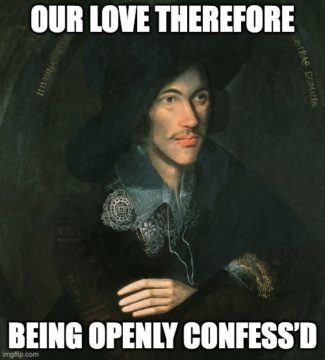
My next alternative-reality contributor, just two millennia later, would take a similar approach to distributed ledger technology. John Donne (1572-1631), an English “Metaphysical” poet of the Baroque period, is prized for his mixture of the sacred and the profane, his use of spiritual images to evoke carnality, and of erotic metaphors to declare his religious faith. “Batter my heart, three-person’d God,” one of his Holy Sonnets opens, “for you / As yet but knock, breathe, shine, and seek to mend…” That poem closes with even greater, more paradoxical passion: “Take me to you, imprison me, for I, / Except you enthrall me, never shall be free, / Nor ever chaste, except you ravish me.” But Donne also led a thoroughly secular life, as a politician and father of ten, and his involvement in quotidian affairs is evidenced by other of his tropes, such as the images drawn from metallurgy and draughtsmanship, in “A Valediction Forbidding Mourning”, to console his lover on his impending absence: “Our two souls therefore, which are one, / Though I must go, endure not yet / A breach, but an expansion, / Like gold to airy thinness beat. / If they be two, they are two so / As stiff twin compasses are two; / Thy soul, the fixed foot, makes no show / To move, but doth, if the other do.” Here, then, in my forked poetical universe, I conjure him deploying a workaday image, drawn from bookkeeping, among the drabbest of “dull sublunary” pursuits, to assuage the pain of being bereft, and to promise future, profitable intimacy:
A Validation Foretelling Minting
When cares of state my going forth compel,
And I am riven by reproaching looks
From her who scarce our separation brooks,
And makes of this, our Paradise, a Hell;
When I must hence, where I would rather dwell,
Bound for a cause which devils kings and dukes:
Then am I minded of those heav’nly books
Which, fastened each to each, our treasure tell.
Then do I whisper to her: we are such
As scrive our bounty private in one tome;
And, though we weather distance, by so much
Are we two linked and bound, till I am home.
Our love therefore, being openly confess’d,
Doth propagate in ciphers, to be blest.
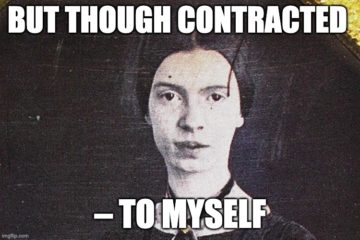
The blockchain, with its immutable, “persisted” links forged in the mathematical certainty of “hashing” and validated publicly by an entire community, may seem an unlikely vehicle for metaphor in the work of my third fantasy contributor, Emily Dickinson (1830-1886), whose enormous corpus of intensely personal, almost solipsistic meditations on internal processes went almost completely unpublished during her lifetime, and which is distinguished by an idiosyncratic style featuring parenthetical interruptions of flow and “unvalidated” punctuation. And yet precisely such an early modernist sensibility, for which conventional religion (as well as society in general) seems to have held little consolation, might have been attracted to the deistic promise of unity and infallibility offered by the “trustless” blockchain, on the verge of the terrible twentieth century. Here then is my ventriloquized, Web3 Emily:
There is a Ledger – manifold;
Unknown its Frequency, and whence.
It chronicles a phantom Gold
Alleged – of its own Genesis.
I launched a Covenant anent
The Filigree – those Copies joins:
And thus cannot be doubly Spent,
Nor Me corporeal, nor Coins.
But though contracted – to Myself,
A Codex kept in kindred Seal
Safeguards my Store – of ghostly Wealth,
And, but it fork, our Commonweal.
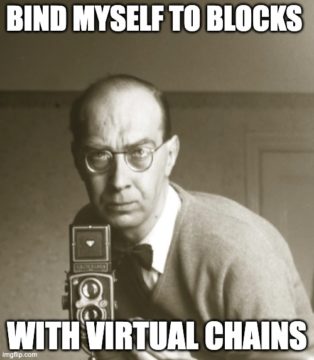
Which takes us to our own immediate past, the hour of the computer’s actual birth and floruit, as well as the grave of millions—people and empires alike—and the cradle of the European Union, among other radical reboots: that very twentieth century which historians have “shortened”—declaring its inception only in 1914 and its premature end in 1991—; although such abbreviation does nothing to lessen its horror. The poet I have chosen to revive from this period is the hardest-nosed of the lot, the most cynically fortified to survive the twentieth century’s conflagrations with his lyricism intact. Philip Larkin (1922-1985), who towards the end of his life was offered the signal honor of serving as Britain’s Poet Laureate, and who declined it, actually worked as a librarian in his “day job” and thus was deeply familiar with the practical challenges of collecting, cataloguing, and conserving information. He was also very much a poet of the modern, post-patronage era, concerned with making ends meet, notable for his occasional profanity as well as for his revelation of the elegance of the everyday, and immersed in the things of ordinary life. Here he is, then, in my alternate reality, grappling with the introduction of the euro to the UK (because “Brexit never happened in here!”) alongside the imminent launch, by the Bank of England, of a trial “central bank digital currency”, a retail CBDC to compete with China’s e-CNY:
Coins of vantage
How bracing was the old imperial pound!
The pence and shillings, each with their own base;
The Latin sobriquets, which made them sound
Like an illicit substance; on each face
A profile pageantry of kings and queens,
Askance, ignored their treasure passed from hand
To grubby hand, exchanged for magazines,
For pints of bitter, and for goods less grand.
Now must we trade for hexadecimal
This suitably eccentric currency,
Skip metric for the boon infinitesimal
Of ciphered, scalable transparency?
No thanks. I’d sooner fill my coffers with
Some grey and dismal continental gains;
Employ, though foreign, yet a coppersmith,
Than bind myself to blocks with virtual chains.
Given the ongoing, perhaps deliberate turmoil besetting the crypto world—a feature, not a bug, of what may in fact simply be a gigantic Ponzi scheme—and the jejune, “cringeworthy” nature of most NFTs in circulation, which depend on the very currencies they were invented to justify, and which are swelling into a gaudy, ugly bubble itching to be burst, maybe this final, fantasy attitude is the best. As all that is air congeals into solids, and everything becomes algorithm, let us cleave to the consolations of the oldest of old-school chains—poetry—; unbroken, in Clive James’s evocation, for millennia: “…the interchange / Of showpiece and attention that has been / There since the cavemen took pains to arrange / Pictures of deer and bison to be seen / To best advantage in the flickering light.” James’s imaginary ancient audience was “drawn to us [poets] by love of sound. / In the first instance, it is how we sing / That brings them in.”
And, even when we are singing for our supper, let payment be made in honest kind, not in crypto.
